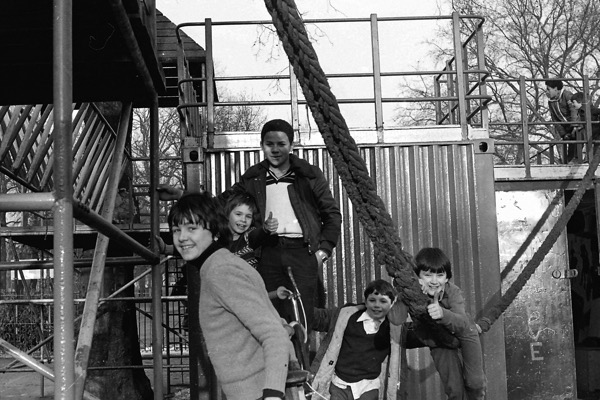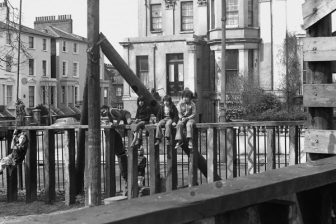
Look back in play – part 4
In the final part of her piece about play and space, inspired by Abdul Chowdry’s discovered photographs of the adventure playground where she played as a child, landscape architect Maisie Rowe reflects on the significance of such places and how this has been neglected by urban planners.
One special corner of this discussion about play and space belongs to landscape architecture: the story of the adventure play movement. This originated in Denmark during World War Two when the landscape architect, C. Theodor Sorensen, watched children playing on bombsites and derelict land and noted the intensity and creativity with which they immersed themselves in outdoor play.
At Emdrup, Sorensen created the first junk playground or skrammellegeplad, which was filled with junk: ‘wood,
rope, canvas, tyres, wire, bricks, pipes, rocks, nets, logs, balls, abandoned furniture, wheels, vehicles, and an unimaginable assortment of other things’, according to Robert Dighton. Sorensen said: ‘It is obvious that the children thrive here and feel well, they unfold and they live.’ What I believe is happening is that such landscapes embody the inner turmoil of the child and, in doing so, give children permission to give expression to this chaotic and disordered emotional landscape.
children thrive here and feel well, they unfold and they live.’ What I believe is happening is that such landscapes embody the inner turmoil of the child and, in doing so, give children permission to give expression to this chaotic and disordered emotional landscape.
Full of possibilities
In 1948, a second landscape architect, the forthright Lady Allen of Hurtwood, scored double points for the landscape profession by introducing the Danish model to Britain. Lady Allen instinctively grasped the significance of the concept: ‘I was completely swept off my feet… In a flash of understanding I realised that I was looking at something quite new and full of possibilities,’ she said. Displaying a curious attitude to risk assessment, she made it a rallying cry to declare, ‘Better a broken bone than a broken spirit!’
we need to talk about how city-makers blindly privileged the motor car over the child.
Sorensen admitted that his playground looked squalid: ‘Of all the things I have helped to realise, the junk playground is the ugliest; yet for me it is the best and most beautiful of my works.’ How curious that this most significant of contributions to landscape architecture should be a sort of anti-design, produced by child builders, with little aesthetic consideration and minimal involvement of the professionalised adult designer.
While this article predominantly concerns the minutiae of the child’s relationship with landscape in the guise of play, the discussion is incomplete without locating the child in the context of the city, however briefly. If we are to take this conversation forward, we need to talk about how city-makers blindly privileged the motor car over the child, sacrificed open space to bricks and mortar, and enclosed children within actual and virtual architectures that curtail their ability to spend time connecting with landscapes in the company of other children.
Maisie Rowe
Maisie Rowe is a landscape architect with a particular interest in play
Photos of Camden Square Community Play Centre by Abdul Chowdry
The complete version of this article was first published by Landscape, the Journal of the Landscape Institute




